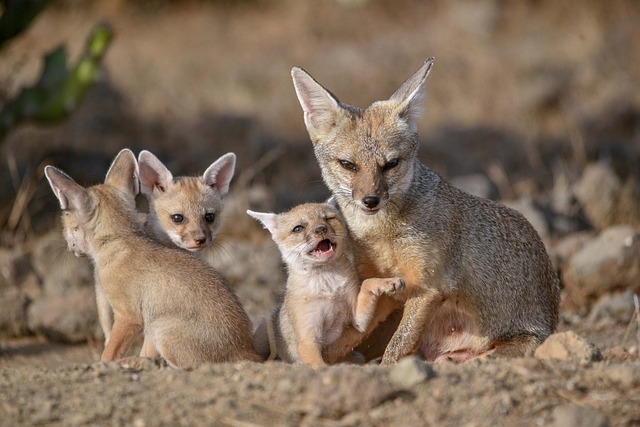Kit fox habitat
Kit foxes, including the desert kit fox (Vulpes macrotis arcipus), are adapted to the diverse arid and semi-arid environments of North America. Here are some common aspects of their habitat:
Desert and dry areas:
Kit foxes are suitable for arid and semi-arid environments including deserts, shrublands, and grasslands. They are often found in areas with sparse vegetation and limited water sources.
Southwestern United States and northern Mexico:
The natural range of the desert kit fox includes the southwestern United States, such as California, Nevada, Arizona, and New Mexico, as well as parts of northern Mexico.
Burrow System:
Kit foxes are skilled diggers and create elaborate burrow systems in the ground. They use these burrows as shelter, protection from predators, and a place to raise their young. These burrows are often repurposed from other animals such as ground squirrels.
Open Terrain:
Kit foxes are adapted to a variety of open terrain, including sandy deserts, dry grasslands, and low shrubland. The color of their fur, typically sandy to grayish-brown, provides effective camouflage in these environments.
Protection from extreme temperatures:
To cope with the extreme temperatures of their habitat, kit foxes are primarily nocturnal. They are more active during the cool hours of the night, and seek shelter in their burrows during the heat of the day.
Limited Water Source:
Kit foxes have developed mechanisms to survive in areas with limited water availability. Although they require water, they can obtain a significant portion of their hydration from their prey.
Human-altered landscapes:
Kit foxes can adapt to human-altered landscapes, including agricultural areas and urban areas to some extent. However, they generally prefer undisturbed natural habitats.
Territorial Behavior:
Kit foxes establish and defend territories within their habitat. These territories often include multiple burrow systems and are marked with scent markings to communicate with other foxes.
What does a kit fox eat
- Small Mammals: Kit foxes primarily eat small mammals, including rodents such as mice, rats, squirrels, and rabbits. They are skilled hunters, using their agility and keen senses to capture these fast and elusive prey.
- Birds: Kit foxes may also eat birds, especially ground-dwelling species. They may hunt small birds or raid nests for eggs.
- Insects: Insects are an important part of the kit fox's diet. They can hunt and consume a variety of insects, such as beetles, grasshoppers, and other arthropods.
- Vegetation: While animal matter makes up the majority of their diet, kit foxes have been known to occasionally eat vegetation. This may include fruits, berries, and plant materials, especially when other food sources are scarce.
- Carrion: Kit foxes are opportunistic scavengers and will eat carrion (flesh of dead animals) when available. This cleaning behavior helps them use resources and energy efficiently.
- Reptiles: Depending on the region, kit foxes may eat reptiles such as lizards and small snakes.

Comments
Post a Comment